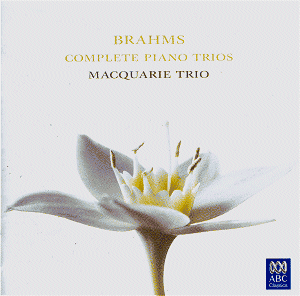Together with the two Clarinet Sonatas, Clarinet Quintet
and Clarinet Trio three of these Trios for violin, cello and piano are
among Brahms’s last works. They represent compelling evidence that,
after some 25 chamber compositions, he had lost none of his free-flowing
inspiration. Of particular interest is the opportunity to compare two
versions of Op. 8, one written when Brahms was in his early twenties
and the other a reworking made eight years before his death in 1897.
The maturity and confidence of the first version which, despite several
amended tempo indications and a change in the time signature of the
first movement from 4/4 to 2/2 (alla breve), merits direct comparison
with the revision. The revision displays – indeed enhances –
the youthful optimism and vivacity of the original. The Macquarie
Trio clearly takes the brisker tempi of the second version seriously,
with a difference of 18.50 in total playing times.
The other rarity here is the Trio in A, discovered
in 1924 by Ernst Bücken of Cologne University among the papers
of the late Dr. Erich Preiger of Bonn. The manuscript lacked a title
page and was written in a hand other than that of Brahms. It nevertheless
bears a close stylistic resemblance to the German master, and was published
in 1938, becoming widely accepted as an unknown work by the young Brahms.
The lyrical opening and broad melodies of the first movement are distinctly
Brahmsian, and the plaintive cantabile of the central section
is particularly touching. The use of a chorale-like theme in the closing
part (Lento) of the second movement is a further reminder that
this was a device that Brahms (who had a deep admiration for J.S.Bach)
often used. The Finale, (Presto) is similarly evocative of Brahms
in an extrovert mood and includes, as well as Hungarian-sounding material,
decidedly Bach-like echoes. The Trio in A is well worth its inclusion
on this disc, not only for the sake of completeness, but also for its
intrinsic qualities. Having also heard the unrevised Op. 8 I have no
difficulty in accepting it as an early work by the German master. Let
the musicologists argue the point if they wish: either way it is a treasure.
So what of the unquestionably authentic works on this
disc? The informative insert booklet is helpful in analysing the Trios
that, with their blend of Classical rigour and Romantic imagination,
are quintessentially Brahmsian. The composer’s introduction of faster
metronome markings in his revision of Op. 8 suggests that he was anxious
to avoid a staid (not to say ‘elderly’) approach: con brio, Allegro
molto (several times), Allegro giocoso, Allegro energico and
Allegro agitato all appear as interpretative markings and, while
the slow movements are sublime, the overall impression is that of sharing
the feelings of a free spirit rather than (as in the Clarinet Quintet)
the autumnal reflections of a retired composer.
The Macquarie Trio responds magnificently, with crisp,
accurate playing and close attention to the syncopated rhythms and chromatic
texture that thread their way through these works. These are carefully
considered, well-rehearsed performances by players who obviously relish
the opportunity of re-introducing all these exciting works into the
chamber repertoire.
Roy Brewer
